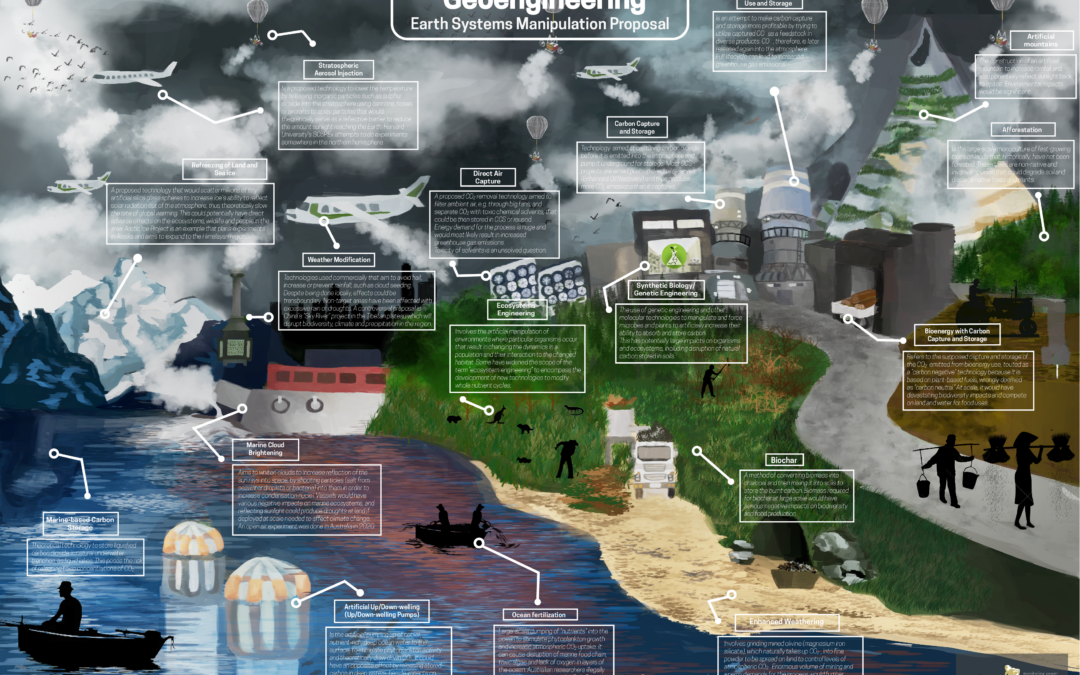As the world faces the multiple challenges of climate, biodiversity and environmental crises, dangerous and unproven technological approaches are being proffered as quick fixes. Instead of supporting serious and often politically painful solutions, desperate politicians and messianic billionaires are advocating technological solutions that, they claim, can fix the climate chaos, resurrect extinct species, restore destroyed ecosystems and even create new environments to harbour new forms of life. Many of these ideas are backed by Big Oil and Big Tech corporations whose businesses are built on extraction of the planet’s minerals, dependence on fossil fuels and exploitation of natural resources. The reality is that these technologies are too dangerous to be deployed or even experimented with in the real world. As the UN Secretary General quipped, “There might be a Plan B, but we do not have a Planet B.”
The most well-known among these earth system manipulation approaches, presented as a last resort or “Plan B”, is geoengineering – the deliberate and planetary scale intervention in earth systems through proposed technologies, with the intent to manipulate ecosystems and counteract some of the effects of climate change. These disruptive technologies can be categorized as:
- Carbon dioxide removal (CDR), which involves removing greenhouse gases from the atmosphere;
- Solar radiation management (SRM), which involves reflecting sunlight back into space to reduce its warming effect; and
- Weather modification, which involves the manipulation of weather.
Geoengineering approaches, especially CDR, have insidiously crept into the global discourse in recent years and in UN proceedings, such as the recent COP27 of the UNFCCC, where it was proposed that carbon removal technologies could qualify for trading in the soon-to-be-established UN-backed carbon market, and be eligible for offsets.
Geoengineering technologies are no solution to the climate crisis. These approaches are environmentally risky and energy hungry, demand huge public subsidies and could result in increased greenhouse emissions and further climate disruption. Geoengineering is also a dangerous distraction from the real solutions needed to confront climate change. Yet, big narratives have evolved in recent years, promoting the normalization of geoengineering as an approach to addressing the climate and biodiversity crises, while protecting the status quo and avoiding deep cuts in greenhouse emissions that are needed to avert climate catastrophe.
The Big Narratives for Geoengineering
A key narrative that has caught on is the so-called ‘net zero’ or ‘climate neutrality’ claim. It is based on the assumption that continued and even increased emissions can be ‘balanced’ by the removal of carbon from the atmosphere, and/or compensated through carbon offsets. However, this is an accounting trick that sanctions the continued extraction of fossil fuels rather than reducing greenhouse gas emissions.
Entities with interests tied to avoiding or delaying the obligation to reduce the extraction and use of fossil fuels are seeking different ways to achieve “climate neutrality” or “net zero emissions”. Among these are the appropriation of natural ecosystems, locking and trading them as carbon sinks; deploying massive crop and tree plantations; and technological proposals. Since land, forests and ecosystems on Earth are finite, a range of technological fixes to artificially remove carbon from the atmosphere are also promoted.
Among the geoengineering proposals included in “net zero” pledges are carbon capture and storage (CCS); carbon capture, utilization and storage (CCUS); direct air capture (DAC); bioenergy with CCS (BECCS); ocean fertilization; enhanced weathering and biochar. These proposed techniques are mostly theoretical and speculative, and have not proven useful in removing carbon from the atmosphere effectively and permanently. In order to have any meaningful impact on the climate, large-scale deployment of CDR technologies would be required, implying the establishment of new transnational extractive industries. These industries and infrastructure deployments would most likely reproduce, or even worsen, unjust patterns of extraction and exploitation of land and resources both in the Global South and in communities impacted by extractive industries in the Global North. Large-scale CDR could have devastating impacts on local communities and natural ecosystems, such as land grabs, human rights violations and sharp increases in food prices. Taking into account the full life cycle of CDR technologies, the large scale, massive resources (land, minerals, biomass) and new infrastructure and facilities required, as well as the high energy and water demands, would translate into an overall increase in greenhouse gas emissions.
Another concept that justifies geoengineering and is associated with “net zero” claims is “nature based solutions” (NBS) or “nature based climate solutions” (NBCS). The term is intentionally vague and ill-defined, to cover measures to appropriate and/or manipulate forests, land, coasts and oceans. Geoengineering proposals that are often included under this concept are large-scale plantations, bioenergy projects with carbon capture and storage (BECCS), large-scale macro algae cultivation, and genetic engineering of plants and soil microbes. BECCS is labelled as a ‘nature-based solution’ despite the fact that monoculture plantations involved in the process are not remotely natural and come with serious risks. The IPCC report in February 2022 posited that proposed methods of carbon dioxide removal such as BECCS and afforestation could compromise ecosystem health and food and water security.
There are also proposals to genetically manipulate crops and trees to absorb more carbon or be more reflective. These combine the risks of geoengineering with the risks of genetic manipulation. There are research projects that aim to genetically engineer soil microbiota to increase the absorption of carbon. Yet genetic engineering of crops and trees has associated adverse impacts that could exacerbate the multiple climate, environmental and biodiversity crises.
Ocean fertilization and large-scale massive plantations of macroalgae are also framed as NBCS. Ocean fertilization is now absurdly renamed “ocean pasture”, “marine biomass regeneration” or “artificial whale poo” in attempts to circumvent the standing moratoria on ocean fertilization in the UN’s Convention on Biodiversity and the London Convention on Ocean Dumping. In the same way, mega-scale cultivation of macroalgae such as kelp is often called ‘marine forest’ – and it is indeed similar to tree monoculture plantations, entailing many of the same problems. Large monocultures of macroalgae threaten the natural marine environment by attracting disease and by displacing biodiversity and the vital food chain that natural macroalgae is embedded in. As with large tree plantations and their impacts on indigenous and rural communities, industrial kelp monocultures are a threat to sound ecosystems and the livelihoods of artisanal algae cultivators. Covering large parts of the sea with kelp and sinking massive amounts of dead kelp to the bottom carry many uncertainties and potential impacts on marine biodiversity. Also, recent scientific articles show that the capacity of kelp to sequester carbon seems to be exaggerated.
Some geoengineering experiments in Asia-Pacific
With little or no public scrutiny, Asia-Pacific has been an experimental ground for geoengineering over the past half century. The US military’s Operation Popeye deliberately manipulated the weather at the height of the Vietnam war to hinder the advance of Vietnamese revolutionaries without regard to the adverse impacts on food production, peoples’ livelihoods and community resilience. The misadventure triggered the adoption of the Environmental Modification Treaty in 1977, where parties committed “not to engage in military or any other hostile use of environmental modification techniques having widespread, long-lasting or severe effects as the means of destruction, damage or injury to another State party”.
An experiment in ocean fertilization, referred to as ocean nourishment by proponents who are Australian scientist-entrepreneurs, took place in the Sulu Seas in 2007/2008 without consent of the government or communities in the Philippines. The project, which involved dumping urea in the sea to boost the growth of phytoplankton that suck carbon from the atmosphere, was explicitly aimed at earning carbon credits for proponents. It was strongly condemned by broad alliances of marine scientists from across the region and Philippine civil society organizations due to serious potential adverse impacts on the marine environment that could endanger fisheries and local livelihoods. The incident triggered the Philippine government to push for a moratorium on ocean fertilization in the UN Convention on Biodiversity in 2008, and on climate geoengineering in 2010.
China has used various techniques to manipulate the weather, from massive cloud seeding operations to produce rain to firing rockets and artillery to ensure clear weather for the opening ceremonies of the Olympic Games in 2008 and national celebrations in 2009. In 2017, a major Chinese military contractor proposed building a massive weather modification network in the dry Tibetan Plateau. The project involves thousands of fuel-burning chambers blasting silver iodide into the atmosphere, stimulating cloud formation and precipitation to channel additional rainfall into China’s northern regions to the tune of 5-10 billion cubic meters per year. This could have devastating effects on the livelihoods of the pastoralists and peasants living on the Tibetan Plateau, as well as unknown effects on global climate patterns.
In 2021, an Australian university with funding from the government conducted open-air experiments on hardware for marine cloud brightening (MCB) in the Great Barrier Reef. The tests involved spraying seawater mist into clouds to increase the amount of light reflected back into space, thus blocking the sunlight, with the hope of saving the corals. Warming seas, however, are just one of several causes of coral bleaching. Ocean acidification, poor water quality due to sediment run-off, pollution from agriculture, aquaculture, coastal development and industry are key factors in coral destruction that MCB does not address. Solar engineering is associated with profound uncertainty and risks, including further disruption of the global climate, unknown feedback effects, and floods and droughts across the global south. The open-air testing of solar geoengineering technology in Australia opened a path to the use of a risky technology that, if deployed at large scale, could be damaging to other regions and even the ocean ecosystems the researchers claim to be trying to protect.
Closing the Door on Geoengineering
As CDR gains ground in climate negotiations and as calls for more research on SRM receive attention beyond the global North, the world needs to assert that these approaches do not merit consideration as Plan B in addressing the multiple crises that we are facing. Geoengineering has long faced strong opposition, as it does not address the root causes of the climate crisis and provides an excuse for high emission governments to avoid confronting the powerful and destructive fossil fuel industry and their growing greenhouse gas emissions.
Geoengineering entails many environmental, geopolitical and economic risks which would be distributed unevenly in the world. Small experiments, whether on land, in the ocean or the air, do not provide meaningful data about geoengineering impacts on the climate or ecological systems, but function as a beachhead to justify larger experiments and open a path to their large-scale adoption. To avert a climate and ecological catastrophe, the world should focus its attention and resources on proven and time-tested community-led approaches that are equitable, socially just and ecologically based.


